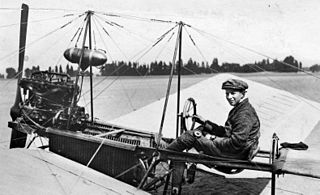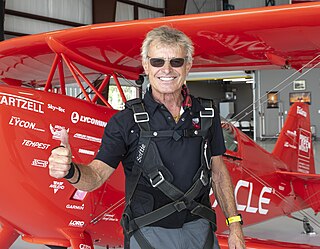
Sywell Aerodrome is the local aerodrome serving the towns of Northampton, Wellingborough, Kettering and Rushden, as well as wider Northamptonshire. The aerodrome is located 5 nautical miles northeast of Northampton and was originally opened in 1928 on the edge of Sywell village.

The Fokker Dr.I, often known simply as the Fokker Triplane, was a World War I fighter aircraft built by Fokker-Flugzeugwerke. The Dr.I saw widespread service in the spring of 1918. It became famous as the aircraft in which Manfred von Richthofen gained his last 17 victories, and in which he was killed on 21 April 1918.

Aerobatics is the practice of flying maneuvers involving aircraft attitudes that are not used in conventional passenger-carrying flights. The term is a portmanteau of "aeroplane" and "acrobatics". Aerobatics are performed in aeroplanes and gliders for training, recreation, entertainment, and sport. Additionally, some helicopters, such as the MBB Bo 105, are capable of limited aerobatic manoeuvres. An example of a fully aerobatic helicopter, capable of performing loops and rolls, is the Westland Lynx.

The Sopwith Camel is a British First World War single-seat biplane fighter aircraft that was introduced on the Western Front in 1917. It was developed by the Sopwith Aviation Company as a successor to the Sopwith Pup and became one of the best-known fighter aircraft of the Great War. Pilots flying Camels were credited with downing 1,294 enemy aircraft, more than any other Allied fighter of the conflict. Towards the end of the war, Camels lost their edge as fighters and were also used as a ground-attack aircraft.

The Red Arrows, officially known as the Royal Air Force Aerobatic Team, is the aerobatics display team of the Royal Air Force (RAF) based at RAF Waddington. The team was formed in late 1964 as an all-Royal Air Force team, replacing a number of unofficial teams that had been sponsored by RAF commands.

The Fokker E.V was a German parasol-monoplane fighter aircraft designed by Reinhold Platz and built by Fokker-Flugzeugwerke. The E.V was the last Fokker design to become operational with the Luftstreitkräfte, entering service in the last months of World War I. After several fatal accidents due to wing failures, the aircraft was modified and redesignated Fokker D.VIII. Dubbed the Flying Razor by post-war pulp-fiction writers, the D.VIII had the distinction of scoring the last aerial victory of the war.

The Sopwith Triplane is a British single seat fighter aircraft designed and manufactured by the Sopwith Aviation Company during the First World War. It has the distinction of being the first military triplane to see operational service.

A triplane is a fixed-wing aircraft equipped with three vertically stacked wing planes. Tailplanes and canard foreplanes are not normally included in this count, although they occasionally are.

Warbirds over Wanaka is a biennial air show in Wānaka, held on the Easter weekend of even-numbered years since 1988. It is held at Wānaka Airport, 10 km south-east of Wānaka, in the southern South Island of New Zealand. Initially conceived by New Zealand live deer recovery pioneer, Sir Tim Wallis, as a show for him to display his collection of World War II aircraft, the event has grown into a major institution. Roads are closed and traffic is detoured around the area during the weekend. Hotels, motels and backpackers around Wānaka are usually booked well in advance. Accommodation is impossible to find if one does not have a booking.

The Battle of Britain Memorial Flight (BBMF) is a Royal Air Force flight which provides an aerial display group usually comprising an Avro Lancaster heavy bomber and two fighters, a Supermarine Spitfire and a Hawker Hurricane. The aircraft are regularly seen at events commemorating the Second World War and upon British State occasions, notably Trooping the Colour, celebrating Queen Elizabeth II's 80th birthday in 2006, and the wedding of Prince William and Catherine Middleton in 2011, and at air displays throughout the United Kingdom and Europe.

The Wildcat Demo Team are the Royal Navy's helicopter aerobatics display team. The team is composed of two AgustaWestland Wildcat HMA.2 anti-submarine (ASW) and anti-surface (ASuW) helicopters, with the aircraft and crews drawn from 825 Naval Air Squadron, based at RNAS Yeovilton , in Somerset.
The Old Rhinebeck Aerodrome is a living museum in Red Hook, New York. It owns many examples of airworthy aircraft of the pioneer era, World War I and the Golden Age of Aviation between the World Wars, and multiple examples of roadworthy antique automobiles.

Raynham George Hanna, was a New Zealand-born fighter pilot who emigrated to England to join the Royal Air Force (RAF). During his RAF career he was a founding member of the Red Arrows aerobatics display team. He also founded The Old Flying Machine Company, which commercially flies Second World War vintage fighter aircraft at air displays around the world, and for television and cinematic productions. He was a Spitfire display pilot in the latter half of the 20th century, noted for his daring aerobatic stunt flying.

The Fokker Spin was the first airplane built by Dutch aviation pioneer Anthony Fokker. The many bracing wires used to strengthen the aircraft made it resemble a giant spider, hence its name Spin, Dutch for "spider".

The Fokker F.I was a prototype German fighter triplane design by Reinhold Platz of World War I. It was an improved version of the V.4 prototype triplane. For many decades, the V.5 was misidentified as the V.4.

Sean Doherty Tucker is an American world champion aerobatic aviator. He was previously sponsored by the Oracle Corporation for many years, performing in air shows worldwide as "Team Oracle". Tucker has won numerous air show championship competitions throughout his career, was named one of the 25 "Living Legends of Flight" by the Smithsonian's National Air and Space Museum in 2003, and was inducted into the National Aviation Hall of Fame in 2008. He has led several efforts to assist youth in learning to fly or becoming involved in general aviation, and currently serves as co-chairman of the Experimental Aircraft Association (EAA)'s Young Eagles program, a role he has held since 2013.
Charlie Hillard was an American aerobatics pilot, and the first American to win the world aerobatics title.

William Lewis "Skip" Stewart, better known as Skip Stewart, is an aerobatic and commercial pilot from the United States. Stewart flies in airshows in the United States and abroad, in his two highly modified Pitts muscle biplanes.
The Flying Lions Aerobatic Team is a South African formation aerobatic team. They fly a four-ship aerobatic display using North American Harvard aircraft. The team operates five aircraft but only uses four in their display, leaving the fifth to be used as a backup. The Flying Lions have been in operation since 1999 when Arnie Meneghelli acquired the Harvard aircraft that the South African Air Force was decommissioning. The Flying Lions participate at many major airshows around South Africa during the airshow season.
















